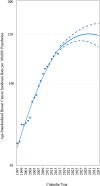Forecast of a future leveling of the incidence trends of female breast cancer in Taiwan: an age-period-cohort analysis
- PMID: 35864141
- PMCID: PMC9304355
- DOI: 10.1038/s41598-022-16056-y
Forecast of a future leveling of the incidence trends of female breast cancer in Taiwan: an age-period-cohort analysis
Abstract
Breast cancer is the most common cancer among women in Taiwan. The age-standardized incidence rate has doubled in just 20 years, causing considerable concern to health professionals and the general public. This study used an ensemble of age-period-cohort models to estimate breast cancer incidence trends in Taiwan from 1997 to 2016 and project trends up to 2035. The (truncated) world standard population (World Health Organization 2000) proportions (age groups: 25-29, 30-34, …, 80-84, and older than 85 years) were used to calculate age-standardized incidence rates. The age-standardized incidence rate from 1997 (60.33/100,000 population) to 2016 (128.20/100,000 population) increased rapidly. The projection is that the increase in the age-standardized incidence will subsequently slow and exhibit a plateau in 2031 (151.32/100,000 population). From 2026 to 2035, the age-specific incidence rates for women older than 55 years old (postmenopausal breast cancer) are projected to increase with larger percentage increments for older women. A future leveling of female breast cancer incidence trends in Taiwan is anticipated. The majority of the patients with breast cancer in the future will be women aged 55 years and older. Education on lifestyle recommendations and mammography screening is required to reduce the burden of breast cancer. The results should have implications for other countries which are also confronted with the same public health problem of rapidly increasing breast cancer incidences.
© 2022. The Author(s).
Conflict of interest statement
The authors declare no competing interests.
Figures


Similar articles
-
Trends in breast cancer by race and ethnicity: update 2006.CA Cancer J Clin. 2006 May-Jun;56(3):168-83. doi: 10.3322/canjclin.56.3.168. CA Cancer J Clin. 2006. PMID: 16737949
-
Nationwide mammographic screening and breast cancer mortality in Taiwan: an interrupted time-series analysis.Breast Cancer. 2022 Mar;29(2):336-342. doi: 10.1007/s12282-021-01315-z. Epub 2021 Nov 26. Breast Cancer. 2022. PMID: 34837139
-
Comparison of annual percentage change in breast cancer incidence rate between Taiwan and the United States-A smoothed Lexis diagram approach.Cancer Med. 2017 Jul;6(7):1762-1775. doi: 10.1002/cam4.1102. Epub 2017 May 31. Cancer Med. 2017. PMID: 28560749 Free PMC article.
-
The contribution of mammography screening to breast cancer incidence trends in the United States: an updated age-period-cohort model.Cancer Epidemiol Biomarkers Prev. 2015 Jun;24(6):905-12. doi: 10.1158/1055-9965.EPI-14-1286. Epub 2015 Mar 18. Cancer Epidemiol Biomarkers Prev. 2015. PMID: 25787716 Free PMC article.
-
Ensemble forecasting of a continuously decreasing trend in bladder cancer incidence in Taiwan.Sci Rep. 2021 Apr 16;11(1):8373. doi: 10.1038/s41598-021-87770-2. Sci Rep. 2021. PMID: 33863962 Free PMC article.
Cited by
-
The epidemiology, treatments and outcomes of patients with hormone receptor positive, human epidermal growth factor receptor 2 negative, node-positive early breast cancer in Taiwan.Future Oncol. 2024;20(37):2983-2992. doi: 10.1080/14796694.2024.2407282. Epub 2024 Oct 4. Future Oncol. 2024. PMID: 39365110 Free PMC article.
-
Warning factors of metachronous uterine cancer in patients with breast cancer: a real-world nationwide cohort study.Gynecol Oncol Rep. 2025 Apr 5;59:101732. doi: 10.1016/j.gore.2025.101732. eCollection 2025 Jun. Gynecol Oncol Rep. 2025. PMID: 40270980 Free PMC article.
-
Identifying breast cancer risk factors and evaluating biennial mammography screening efficacy using big data analysis in Taiwan.Sci Rep. 2025 May 9;15(1):16250. doi: 10.1038/s41598-025-00984-6. Sci Rep. 2025. PMID: 40346112 Free PMC article.
-
Projected Time for the Elimination of Cervical Cancer Under Various Intervention Scenarios: Age-Period-Cohort Macrosimulation Study.JMIR Public Health Surveill. 2024 Apr 18;10:e46360. doi: 10.2196/46360. JMIR Public Health Surveill. 2024. PMID: 38635315 Free PMC article.
-
Incidence trends and spatial distributions of lung adenocarcinoma and squamous cell carcinoma in Taiwan.Sci Rep. 2023 Jan 30;13(1):1655. doi: 10.1038/s41598-023-28253-4. Sci Rep. 2023. PMID: 36717588 Free PMC article.
References
-
- WHO. Breast cancer now most common form of cancer: WHO taking action, https://www.who.int/news/item/03-02-2021-breast-cancer-now-most-common-f... (2021).
Publication types
MeSH terms
LinkOut - more resources
Full Text Sources
Medical

